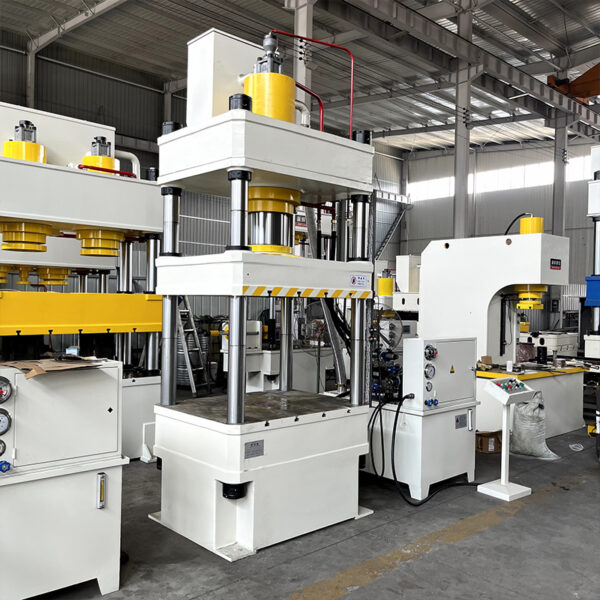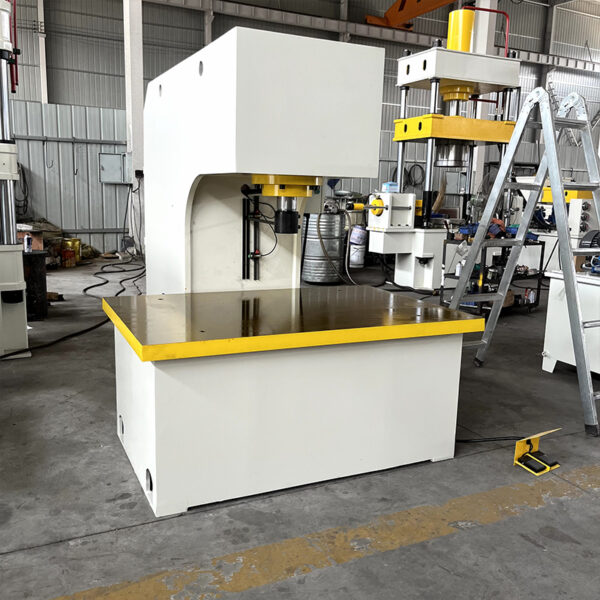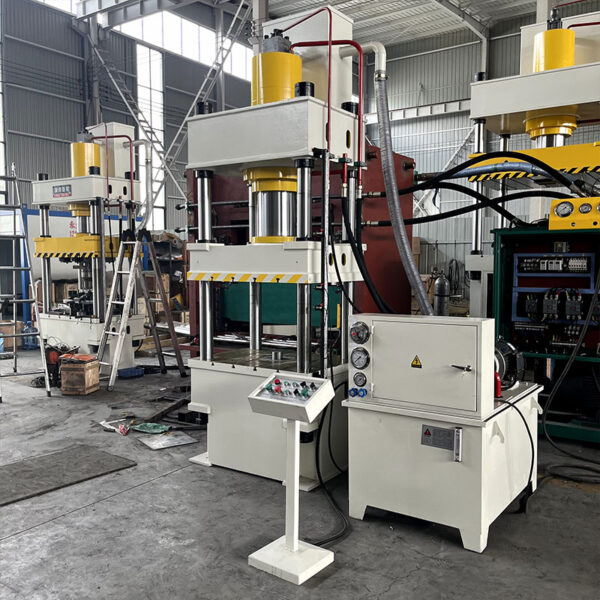Hydraulic presses are versatile industrial machines used for shaping, forming, and compressing materials across various industries. This guide provides an overview of how hydraulic presses work, their main types, and key considerations for selecting the right equipment.
1. How Hydraulic Presses Work
Hydraulic presses operate based on Pascal’s Law, which states that pressure applied to a confined fluid is transmitted equally in all directions. By applying a small force to a pump piston, hydraulic fluid pressurizes and drives a larger main cylinder piston, amplifying the output force. The formula is:
Output Force = Input Force × (Main Cylinder Area / Pump Area)
This principle allows hydraulic presses to generate massive forces even with minimal input energy.
2. Main Types of Hydraulic Presses and Their Applications
Four-Column Hydraulic Press
- Structure & Features:
Four vertical columns support upper and lower beams, forming a rigid closed frame. Capacity ranges from 50 to over 10,000 tons. Long stroke and large table size make it ideal for oversized workpieces. - Applications:
- Automotive: Car door stamping, engine hood forming.
- Home Appliances: Refrigerator panel stretching, washing machine tub molding.
- Composites: Carbon fiber lamination, fiberglass (FRP) molding.
- Metal Forging: Pre-forging of large gears and bearing blanks.
- Advantages: High resistance to off-center loads, flexible mold setup, and suitability for mass production.
C-Frame Hydraulic Press
- Structure & Features:
Compact C-shaped or solid frame design with an open front for easy access. Capacity ranges from 20 to 2,000 tons. High precision and speed for small-to-medium parts. - Applications:
- Electronics: Smartphone metal frame stamping, connector pin crimping.
- Precision Parts: Bearing pressing, micro-gear forming.
- Rubber Products: O-ring vulcanization, silicone button molding.
- Advantages: Compact footprint, easy automation integration, and ideal for precision tasks.
Closed-Die Hydraulic Press
- Structure & Features:
Fully enclosed frame maximizes rigidity and minimizes energy loss. Capacity ranges from 100 to 5,000 tons. Designed for hot forging and isostatic pressing. - Applications:
- Aerospace: Turbine blade hot forging, titanium alloy component forming.
- Defense: Armor plate stamping, artillery shell cold extrusion.
- Powder Metallurgy: Metal powder isostatic pressing (e.g., carbide tools).
- Advantages: High energy efficiency, suitability for extreme conditions, and uniform density in formed parts.
Single/Double-Action Hydraulic Press
- Structure & Features:
- Single-Action: Only the main cylinder provides force; simple and cost-effective.
- Double-Action: Main cylinder + ejector cylinder for deep drawing.
Capacity ranges from 100 to 6,000 tons.
- Applications:
- Single-Action: Flat vulcanization, simple punching (e.g., metal trays).
- Double-Action: Automotive fuel tank deep drawing, stainless steel cookware forming.
- Advantages: Double-action presses reduce wrinkling in complex geometries.
3. How to Choose the Right Hydraulic Press
| Key Factors | Explanation |
|---|---|
| Workpiece Size & Material | Large parts require four-column presses; small precision parts suit C-frame. |
| Process Type | Deep drawing needs double-action; isostatic pressing requires closed dies. |
| Production Volume | Mass production: four-column; low-volume customization: C-frame. |
| Budget & Energy Efficiency | Closed-die presses save energy but cost more; single-action is cheaper but limited. |
4. Conclusion
Selecting the appropriate hydraulic press depends on workpiece requirements, process type, and production costs. Four-column presses are ideal for heavy-duty versatility, while C-frame presses excel in precision tasks. Closed-die presses are best for high-pressure density forming, and single/double-action types optimize drawing complexity. Understanding these differences ensures maximum productivity and quality in manufacturing operations.









